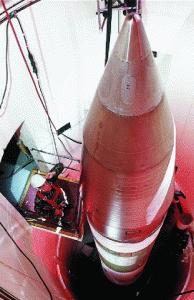After years of contentious debate within NATO about the presence of American nuclear weapons in Europe, the United States faces a critical decision about whether or not to spend billions of increasingly scarce defense dollars on the upgrades needed to keep these weapons in service. Last Thursday I attended an event hosted by the Stimson Center regarding this issue.
Former Air Force Chief of Staff, General Norton Schwartz, along with former Ambassador to Germany and Ronald Reagan’s START negotiator, Richard Burt, discussed the logic for the military and diplomatic utility of these weapons. They explained why they joined 15 other distinguished defense thinkers on the Peterson Defense Advisory Committee in calling for reductions in tactical nuclear weapons.
Drawing on the Committee’s recent report, Strategic Agility, the event brought a wealth of national security expertise to offer a clear-eyed perspective on how policymakers on both sides of the Atlantic should approach decisions about US tactical nuclear weapons.
Remarks from General Schwartz included concerns over our current nuclear bomber capabilities, as well as the aging out of our theatre strike delivery platforms. But he noted that they may still have a sufficient lifespan of around 20 more years.
He reiterated the fact that the NATO Alliance has declared on multiple occasions, most recently in 2010 and 2012, that a nuclear capability is essential to Alliance Security. This suggests that there can be little debate about the policy commitment of the allies to the NATO nuclear deterrent posture. However, what is debatable is the level of NATO financial commitment to sustaining the resulting theatre nuclear capability.
So where does this leave us today?
According to Schwartz, it is important for the NATO allies to manifest not only financial, but also policy commitment to the NATO nuclear posture.
He also makes note of the F-35 and whether or not pursuing nuclear capabilities with this aircraft is the best use of investment dollars. Furthermore, B-61 life extension is necessary independent of F-35 nuclear integration.
“Without financial buy in by the NATO partners, either the F-35 nuclear integration or through fielding of an independent or an equivalent and enduring European manufactured fighter aircraft, F-35 investment dollars should re-align to the long range strike bomber” – General Schwartz
Ambassador Burk suggests that we must reduce the deployment of air delivered tactical nuclear weapons deployed in Europe. However, the proposal discussed in the Strategic Agility Report that includes phasing out the B-61 delivered by attack aircraft deployed in Europe is politically controversial, and it does need to be fully discussed with our European allies.
The concern in the past was if there was not a collaborative approach to nuclear policy, the countries might decide to unilaterally obtain a nuclear weapon. This has made the nuclear mission in NATO more of a shared, multilateral mission.
Ambassador Burk goes on to make further points:
- The perceived need in Europe to have a nuclear mission has largely disappeared since the end of the Cold War.
- There is not a strong desire in Europe for aircraft to have a nuclear mission, i.e. the F-35.
- In the case of the Netherlands that may buy the F-35, they are debating if they even want it.
- Many, if not all delivery countries in Europe are not even going to have the capability in 20 years time to even deliver these weapons.
“Aren’t we sort of sleep walking into unilateral disarmament, while at the same time spending money for a weapon system that no one wants to use?” – Ambassador Burk
- The only countries that might have concerns over taking away the nuclear fighter capabilities in Europe might be some of the newer members of the alliance that still have a residual concern about Russia – Poland and the Baltic States.
- We should continue to actively be taking steps to reassure these countries of the American commitment to look out for them.
- Poland has been chosen as a site for the new NATO missile defense system.
- The Baltic States are being embraced by NATO in a variety of ways, i.e. military exercises and deployments to those countries
- The perceived political requirement for the allies to both participate in nuclear delivery and the sense of need to have tangible nuclear weapons in Europe has disappeared.
His closing remarks point out that in the current era, we get plenty of extended deterrence through our military presence in Europe overall, but perhaps more importantly through our robust and capable strategic forces’ capability; like intercontinental ballistic missiles, sea based nuclear deterrence, and the man bombers.
“Finally, we can certainly maintain a viable nuclear deterrent posture with fewer weapons. This was the logic behind New Start, after all. But as President Obama has indicated, 0 is not a likely outcome in our lifetime.” – General Schwartz
The post Benefit or Burden? The Future of U.S. Tactical Nuclear Weapons appeared first on American Security Project.



